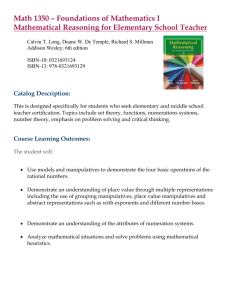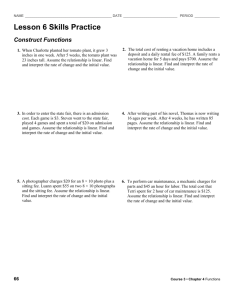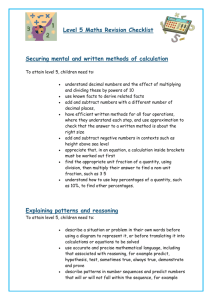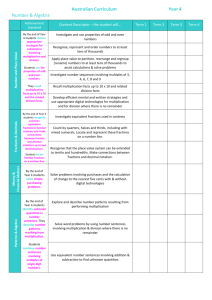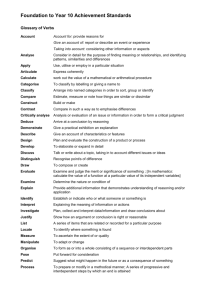Mathematics: Core Learning Outcomes for Years 1 to 10
advertisement
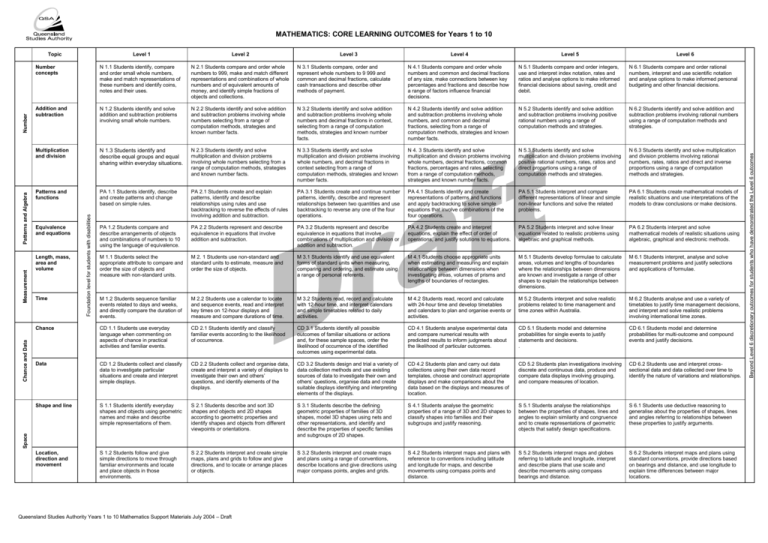
MATHEMATICS: CORE LEARNING OUTCOMES for Years 1 to 10 Level 2 Level 3 Level 4 Level 5 Level 6 N 1.1 Students identify, compare and order small whole numbers, make and match representations of these numbers and identify coins, notes and their uses. N 2.1 Students compare and order whole numbers to 999, make and match different representations and combinations of whole numbers and of equivalent amounts of money, and identify simple fractions of objects and collections. N 3.1 Students compare, order and represent whole numbers to 9 999 and common and decimal fractions, calculate cash transactions and describe other methods of payment. N 4.1 Students compare and order whole numbers and common and decimal fractions of any size, make connections between key percentages and fractions and describe how a range of factors influence financial decisions. N 5.1 Students compare and order integers, use and interpret index notation, rates and ratios and analyse options to make informed financial decisions about saving, credit and debit. N 6.1 Students compare and order rational numbers, interpret and use scientific notation and analyse options to make informed personal budgeting and other financial decisions. Addition and subtraction N 1.2 Students identify and solve addition and subtraction problems involving small whole numbers. N 2.2 Students identify and solve addition and subtraction problems involving whole numbers selecting from a range of computation methods, strategies and known number facts. N 3.2 Students identify and solve addition and subtraction problems involving whole numbers and decimal fractions in context, selecting from a range of computation methods, strategies and known number facts. N 4.2 Students identify and solve addition and subtraction problems involving whole numbers, and common and decimal fractions, selecting from a range of computation methods, strategies and known number facts. N 5.2 Students identify and solve addition and subtraction problems involving positive rational numbers using a range of computation methods and strategies. N 6.2 Students identify and solve addition and subtraction problems involving rational numbers using a range of computation methods and strategies. Multiplication and division N 1.3 Students identify and describe equal groups and equal sharing within everyday situations. N 2.3 Students identify and solve multiplication and division problems involving whole numbers selecting from a range of computation methods, strategies and known number facts. N 3.3 Students identify and solve multiplication and division problems involving whole numbers, and decimal fractions in context selecting from a range of computation methods, strategies and known number facts. N 4. 3 Students identify and solve multiplication and division problems involving whole numbers, decimal fractions, common fractions, percentages and rates selecting from a range of computation methods, strategies and known number facts. N 5.3 Students identify and solve multiplication and division problems involving positive rational numbers, rates, ratios and direct proportions using a range of computation methods and strategies. N 6.3 Students identify and solve multiplication and division problems involving rational numbers, rates, ratios and direct and inverse proportions using a range of computation methods and strategies. Patterns and functions PA 1.1 Students identify, describe and create patterns and change based on simple rules. PA 2.1 Students create and explain patterns, identify and describe relationships using rules and use backtracking to reverse the effects of rules involving addition and subtraction. PA 3.1 Students create and continue number patterns, identify, describe and represent relationships between two quantities and use backtracking to reverse any one of the four operations. PA 4.1 Students identify and create representations of patterns and functions and apply backtracking to solve simple equations that involve combinations of the four operations. PA 5.1 Students interpret and compare different representations of linear and simple non-linear functions and solve the related problems. PA 6.1 Students create mathematical models of realistic situations and use interpretations of the models to draw conclusions or make decisions. PA 1.2 Students compare and describe arrangements of objects and combinations of numbers to 10 using the language of equivalence. PA 2.2 Students represent and describe equivalence in equations that involve addition and subtraction. PA 3.2 Students represent and describe equivalence in equations that involve combinations of multiplication and division or addition and subtraction. PA 4.2 Students create and interpret equations, explain the effect of order of operations, and justify solutions to equations. PA 5.2 Students interpret and solve linear equations related to realistic problems using algebraic and graphical methods. PA 6.2 Students interpret and solve mathematical models of realistic situations using algebraic, graphical and electronic methods. M 1.1 Students select the appropriate attribute to compare and order the size of objects and measure with non-standard units. M 2. 1 Students use non-standard and standard units to estimate, measure and order the size of objects. M 3.1 Students identify and use equivalent forms of standard units when measuring, comparing and ordering, and estimate using a range of personal referents. M 4.1 Students choose appropriate units when estimating and measuring and explain relationships between dimensions when investigating areas, volumes of prisms and lengths of boundaries of rectangles. M 5.1 Students develop formulae to calculate areas, volumes and lengths of boundaries where the relationships between dimensions are known and investigate a range of other shapes to explain the relationships between dimensions. M 6.1 Students interpret, analyse and solve measurement problems and justify selections and applications of formulae. M 1.2 Students sequence familiar events related to days and weeks, and directly compare the duration of events. M 2.2 Students use a calendar to locate and sequence events, read and interpret key times on 12-hour displays and measure and compare durations of time. M 3.2 Students read, record and calculate with 12-hour time, and interpret calendars and simple timetables related to daily activities. M 4.2 Students read, record and calculate with 24-hour time and develop timetables and calendars to plan and organise events or activities. M 5.2 Students interpret and solve realistic problems related to time management and time zones within Australia. M 6.2 Students analyse and use a variety of timetables to justify time management decisions, and interpret and solve realistic problems involving international time zones. Chance CD 1.1 Students use everyday language when commenting on aspects of chance in practical activities and familiar events. CD 2.1 Students identify and classify familiar events according to the likelihood of occurrence. CD 3.1 Students identify all possible outcomes of familiar situations or actions and, for these sample spaces, order the likelihood of occurrence of the identified outcomes using experimental data. CD 4.1 Students analyse experimental data and compare numerical results with predicted results to inform judgments about the likelihood of particular outcomes. CD 5.1 Students model and determine probabilities for single events to justify statements and decisions. . CD 6.1 Students model and determine probabilities for multi-outcome and compound events and justify decisions. Data CD 1.2 Students collect and classify data to investigate particular situations and create and interpret simple displays. CD 2.2 Students collect and organise data, create and interpret a variety of displays to investigate their own and others’ questions, and identify elements of the displays. CD 3.2 Students design and trial a variety of data collection methods and use existing sources of data to investigate their own and others’ questions, organise data and create suitable displays identifying and interpreting elements of the displays. CD 4.2 Students plan and carry out data collections using their own data record templates, choose and construct appropriate displays and make comparisons about the data based on the displays and measures of location. CD 5.2 Students plan investigations involving discrete and continuous data, produce and compare data displays involving grouping, and compare measures of location. CD 6.2 Students use and interpret crosssectional data and data collected over time to identify the nature of variations and relationships. Shape and line S 1.1 Students identify everyday shapes and objects using geometric names and make and describe simple representations of them. S 2.1 Students describe and sort 3D shapes and objects and 2D shapes according to geometric properties and identify shapes and objects from different viewpoints or orientations. S 3.1 Students describe the defining geometric properties of families of 3D shapes, model 3D shapes using nets and other representations, and identify and describe the properties of specific families and subgroups of 2D shapes. S 4.1 Students analyse the geometric properties of a range of 3D and 2D shapes to classify shapes into families and their subgroups and justify reasoning. S 5.1 Students analyse the relationships between the properties of shapes, lines and angles to explain similarity and congruence and to create representations of geometric objects that satisfy design specifications. S 6.1 Students use deductive reasoning to generalise about the properties of shapes, lines and angles referring to relationships between these properties to justify arguments. Location, direction and movement S 1.2 Students follow and give simple directions to move through familiar environments and locate and place objects in those environments. S 2.2 Students interpret and create simple maps, plans and grids to follow and give directions, and to locate or arrange places or objects. S 3.2 Students interpret and create maps and plans using a range of conventions, describe locations and give directions using major compass points, angles and grids. S 4.2 Students interpret maps and plans with reference to conventions including latitude and longitude for maps, and describe movements using compass points and distance. S 5.2 Students interpret maps and globes referring to latitude and longitude, interpret and describe plans that use scale and describe movements using compass bearings and distance. S 6.2 Students interpret maps and plans using standard conventions, provide directions based on bearings and distance, and use longitude to explain time differences between major locations. Equivalence and equations Length, mass, area and volume Time Foundation level for students with disabilities Number concepts Queensland Studies Authority Years 1 to 10 Mathematics Support Materials July 2004 – Draft Beyond Level 6 discretionary outcomes for students who have demonstrated the Level 6 outcomes Level 1 Space Chance and Data Measurement Patterns and Algebra Number Topic
